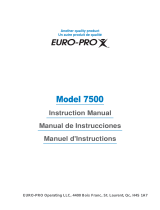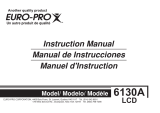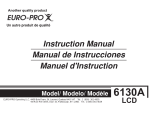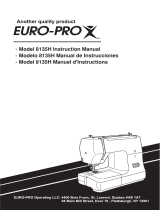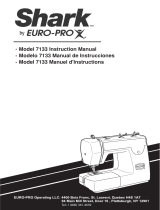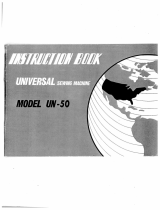Page is loading ...

Instruction Manual
Instruccion Manual
380A
Model / Modelo
EURO-PRO Operating LLC: Boston, MA, 02465
4400 Bois Franc, St. Laurent, Quebec H4S 1A7
Tel.: 1 (800) 361-4639, www.euro-pro.com
Another quality product from

2
IMPORTANT SAFETY INSTRUCTIONS
When using an electrical appliance, safety precautions should
always be followed, including the following:
Read all instructions before using this sewing machine.
Danger - To reduce the risk of electric shock:
1. An appliance should never be left unattended when plugged in.
2. Always unplug this appliance from the electrical outlet immediately
after using and before cleaning.
3. Always unplug before relamping. Replace bulb with same type
rated 10 watts.
Warning - To reduce the risk of burns, fire, electric shock, or
injury to persons:
1. Do not allow to be used as a toy. Close attention is necessary
when this appliance is used by or near children.
2. Use this appliance only for its intended use as described in this
manual. Use only attachments recommended by the
manufacturer as contained in this manual.
3. Never operate this appliance if it has a damaged cord or plug, if it
is not working properly, if it has been dropped or damaged, or
dropped into water. Return the appliance to EURO-PRO
Operating LLC for examination, repair, electrical or mechanical
adjustment.
4. Never operate the appliance with any air openings blocked. Keep
ventilation openings of the sewing machine and foot controller
free from accumulation of lint, dust and loose cloth.
5. Keep fingers away from all moving parts. Special care is
required around the sewing machine needle.
6. Always use the proper needle plate. The wrong plate can
cause the needle to break.
7. Do not use bent needles.
8. Do not push or pull fabric while stitching. It may deflect the
needle causing it to break.
9. Switch the sewing machine off (“0”) when making any
adjustments in the needle area, such as threading needle,
changing needle, threading bobbin or changing presser foot,
and the light.
10. Always unplug sewing machine from electrical outlet when
removing covers, lubricating or when making any other user
servicing adjustments mentioned in the instruction manual.
11. Never drop or insert any object into any opening.
12. Do not use outdoors.
13. Do not operate where aerosol (spray products) are being
used or where oxygen is being administered.
14. To disconnect, turn all controls to the off (“0”) position, then
remove plug from outlet.
15. Do not unplug by pulling on cord. To unplug, grasp the plug,
not the cord.
SAVE THESE INSTRUCTIONS
This sewing machine is intended for household use only.

4
Congratulations:
As the owner of a new sewing machine, you will enjoy precision
quality stitching on all types of fabrics, from multiple layers of
denim to delicate silks.
Your sewing machine offers the ultimate in simplicity and ease of
operation. For your safety and to fully enjoy the many advantages
and ease of operation of your sewing machine, we recommend that
you read all the important safeguards and use and care
instructions in this instruction book.
May we suggest that before you start to use your sewing machine,
you discover the many features and advantages by going through
this instruction book, step by step, while seated at your sewing
machine.
Estimado Cliente:
Le felicitamos muy cordialmente por su nueva máquina de
coser.
Vd. Acaba de comprar un producto de calidad que ha sido
fabricado con máximo cuidado. Su máquina de coser ed
fácil de usar pero naturalmente hay que seguir las reglas. Y
estas las hemos especificado en este manual de
instrucciones. Si Vd. les presta atención entonces realizará
sus trabajos perfectamente desde el comienzo.
Por supuesto que Vd. Tendrá algunas preguntas que en
este manual no hemos podido agotar del todo. En este
caso el representante de nosotro estará siempre a su
disposición, para cualquier pregunta qu Vd. pueda tener.
Le deseamos buen divertimiento con su hobby. De rienda
suelta a su máquina de coser y a su fantasía.

5
Principal parts / Detalles de la máquina
1. Pattern selector dial
2. Take up lever
3. Thread tension dial
4. Thread guide for upper threading
5. Presser foot
6. Shuttle cover
7. Extension table
8. Spool pin
9. Top cover
10. Stitch length dial
11. Reverse button
1. Boton selector de puntos
2. Take up lever
3. Tensión del hilo
4. Thread guide for upper threading
5. Prensstela
6. La tapa con charnela
7. Mesa plana corrediza y coja de accesorios
8. Devanadera
9. Top cover
10. Disco de la longitud de puntada
11. Reverse button

6
Principal parts / Detalles de la máquina
12. Bobbin winder spindle
13. Bobbin winder stopper
14. Stop motion knob
15. Hand wheel
16. Handle
17. Upper thread guide
18. Face cover
19. Presser foot lever
20. Thumb screw
21. Needle plate
22. Needle clamp screw
12. Bobbin winder spindle
13. Bobbin winder stopper
14. Stop motion knob
15. Volante
16. Handle
17. Upper thread guide
18. Face cover
19. Presser foot lever
20. Thumb screw
21. Placa de la aguja
22. Needle clamp screw

7
Accessories / Accesorios
Standard Accessories
1. Bobbins (3)
2. Felt (2)
3. Machine oil
4. Seam ripper
5. Screw driver
6. Set of needles
7. Zigzag foot (on machine)
Bonus Feet
A. buttonhole foot
B. Button sewing foot
C. Zipper foot
D. Blind stitch foot
12 3
45 6
7
BA
CD
Standard Accesorios
1. Canillas (3)
2. Fieltro (2)
3. Aceitera
4. Corta-ojales
5. Destornillador
6. Agujas
7. Pie universal
Bonus Feet
A. Pie para ojales
B. Pie para coser botones
C. Pie para cremallera
D. Pie para punto invisible

8
Threading the upper thread / Enhebrado del hilo superior
Caution: Before threading, turn the power switch to “Off”.
• Raise the needle bar to its highest position.
• Follow exactly the lettered threading sequence illustrated. If you skip a
step or fail to properly engage the thread in any of the thread guides, the
machine will not sew properly.
• Continue to draw the thread down and into the needle bar thread guide.
• Insert the thread though the eye of the needle from front to back.
• Leave about 4” (10cm) of thread loose behind the needle.
• Enhebre la aguja por las siguientes posiciones.: Guiahilos de tapa superior,
regulador de tensión, muelle de tirahilos, palanca tirahilos, guiahilo del
brazo, guiahilo de la barra de aguja.
• Enhebre la aguja pasando el hilo desde el frente hacia el reverso por el ojo
de la aguja y deje más a menos 4 pulgadas (10 cm) hilo.
Atención: El interruptor principal tiene que estar a “off”.
Subir la prensatela.

9
Twin needle (not included) / Agujas gemelas (no incluso)
• Turn stitch length dial to the desired stitch length.
•Turn stitch selector to straight stitch.
• Make sure that the two threads used to thread the twin needle are of
the same weight. You can use one or two colors.
• Insert the twin needle in the same way as a single needle. Flat side
should face away from you.
• Follow instructions for single needle threading. Thread each needle
separately.
Please Note: When sewing with twin needle, always proceed
slowly, and make sure to maintain a low speed to
insure quality stitching.
• Regular la máquina según la ilustración.
• Su máquina de coser esta construida especialmente para tener la
opción de coser con agujas gemelas (no incluso) colocando otro eje
de carretas en el hoyo que está en la parte superior de la máquina,
puede usar uno o dos colores de hilo.
• Asgúrese que los hilos sean del mismo peso. Si los hilos no son del
mismo peso la puntada no será correcta.
• Eje portacarrete extra.
Como poner la aguja gemela (no incluso)
• Póngala de la misma manera que la aguja simple, con el lado plao
hacia atrás y la ranura hacia usted.
Como enhebrar agujas gemelas (no incluso)
• Siga las instrucciones para enhebrar aguja sencilla pero hebre cada
aguja separadamente. La ranura debe de estar hacia usted.

10
Fitting the snap-in sewing table / Ajusta la snap-in mesa plana corrediza
Hold the snap-in sewing table horizontally and push it in
the direction of the arrow. (See fig. 1)
The inside of the snap-in sewing table can be used as
an accessory box.
To open, pull up at the point of the arrow as shown.
Giarda la horizontalidad de la snap-in mesa plana
corrediza y lo empuje a la dirección de la saeta. (Mirar
figura 1)
El interior de la snap-in puede utilizar como una caja
accesoria.
Levante le tapa desde el puntomde la saeta para abrir.

11
Connecting machine to power source / Conecta la máquina al fuente eléctrico
This machine is equipped with a polarized plug which must be used with
an appropriate electrical outlet.
Connect the machine to a power source as illustrated below.
The power switch is located above the terminal box. Your machine will
not operate unless this switch is “On”.
Sewing light turns on automatically when the main switch is “On”.
To start the machine, press on the foot control.
The speed of the machine is regulated by the amount of pressure
exerted on the foot control.
(See fig. 1)
CAUTION:
Always make sure that the machine is unplugged from power
source and the main switch is on “Off” when the machine is not in
use and before inserting or removing parts.
ATENCION:
Desenchufe la máquina del toma corriente
cuando no la use.
Conecte la máquina a un fuente eléctrico según la ilustración.
Este dispositivo tiene un enchufe polarizado para lo que le instale el toma
apropiado
.
Pedal de control
El pedal de control puede regular ;a velocidad de coser.
Alumbrado de trabajo
Conectar el interruptor principal “C” para le eléctrica y la luz. (Mirar figura 1)
Fig. 1
IMPORTANT NOTICE
This appliance has a polarized plug (one
blade is wider than the other). To reduce
the risk of electric shock, this plug will fit in
a polarized outlet only one way. If the plug
does not fit fully in the outlet, reverse the
plug. If it still does not fit, contact a
qualified electrician. Do not modify the
plug in any way.

12
Changing the bulb / Cambio de la bombilla
• Open face cover in direction of arrow.
(See fig. 1)
• Remove bulb by unscrewing it anti-
clockwise.
• Install a new bulb by screwing it in
clockwise.
• Use a screw type bulb with 15W (Max).
• El interruptor de la luz se encuentra en dentro
de la tapa frontal. (Mirar figura 1)
• Para cambiar el bombillo
Para remover - Destornille
Para reponerm - Atornille
• El bombillo
Use un bombillo de 15 vatios.
Fig. 1
CAUTION:
Make sure to disconnect the electrical
supply from the wall outlet before changing
the bulb.
ATENCIÓN:
Desenchufar la máquina de la red eléctrical.

13
Two-step presser foot lever / Palanca alza-prensatelas con dos escalones
When sewing several layers of thick fabric, the presser foot can be
raised to a second higher level to facilitate the placement of the fabric
“A”. (See fig. 1)
Para coser ropas extremamente gruesas se puede ensanchar el pasaje
de la ropa del pie subiendo la palanca del alza-prensatelas de un escalón
“A”. (Mirar figura 1.)
Fig. 1
Adjusting the presser foot pressure / Adjuste de la presion del pie prensatia
Open the face cover to readjust the presser foot
pressure regulator.
1. Move the lever up or down for the desired
pressure. For light fabrics set lever at 1, set at 2 for
medium fabrics and 3 for heavy fabrics. (See fig. 2.)
2. Insufficient pressure may cause poor feeding,
skipped stitches or difficulty in guiding the fabric.
3. When darning or sewing freehand embroidery,
release the pressure by setting the lever on “0”.
(See fig. 3.)
Fig. 2
Fig. 3
La presiõn del pie prensatela de la máquina ha sido
preseleccionada y no requiere especiales ajustes de
acuerdo con el tipo de tejido (liviano o pesdo). (Mirar
figura 2 & 3)

14
Drop Feed Control / Control De Gota
A. Push feed dog lever down to drop feed dog below needle plate for
darning, embroidery and button sewing.
B. Push feed dog lever up to raise feed dog above needle plate for
normal sewing. (See fig. 1)
A. Gira el control de alimento de gota a la derecha (bajar el gancho).
(Mirar figura 1)
Fig. 1

15
Raise the needle to its highest position and raise the presser foot lever. Attach the
presser foot holder "b" to the presser foot bar ”a”. (See fig. 1)
Attaching the presser foot:
Lower the presser foot bar "a" until the groove "c" is directly above the pin "d".
(See fig. 2)
Lower the presser foot bar "a" and the presser foot ’f' will engage automatically
.
Removing the presser foot:
Raise the presser foot.
Release the presser foot by raising lever “e” located at the back of the foot holder.
(See fig. 3)
Attaching the seam guide:
Attach the seam guide "g” in the slot as illustrated. Adjust the distance as required
for hems, pleats, etc. (See fig. 4)
Levantar la barra prensatelas "a" (fig. 1) e introducir el porta-pie "b" como en la
ilustración.
Montaje del pie
Bajar la barra prensatelas "a" hasta que la ranura "c" esté directamente sobre la
espiga "d". (fig. 2)
Empujar ligeramente la palanca "e" hacia adelante. Bajar la barra prensatelas "a"
y el pie ’f' se quedará libre.
Desmontaje de pie
Levantar el pie. (fig. 3)
Apretar ligeramente la palanca “e” hacia adelaante y entonces el pie quedará
libre.
Montaje de la regla de borde
Montar la regla de borde “g” con cuidado, como en la ilustración. Para dobladillos,
pliegues, etc. (fig. 4)
Attaching the presser foot holder / Montaje del porta-pie
Attention: Turn the power switch to “off” before carrying out
any of the operations below.
Atención: Cualquier manipulación debe efectuarse con el interruptor
principal a "off"!

16
Winding the bobbin / Embobinado del hilo inferior
1. Release clutch by turning clutch knob toward you.
2. Draw thread from spool through bobbin winder tension disc
from front to back as shown.
3. Pull end of thread through hole in bobbin as shown.
4. Place bobbin onto bobbin winder shaft with end of thread
coming from the top of the bobbin. Push bobbin winder
shaft to the right until it clicks.
5. Wind thread until winder stops. Remove bobbin and clip
thread.
6. Tighten clutch knob.
1. Suelte el embrague girando la perilla del embrague hacia usted.
2. Pase el hilo del carretel por el disco de tensión de la devanadora de
adelante a atrás como lo indica la ilustración.
3. Pase el extremo del hilo por el orificio de la bobina, como se ilustra.
4. Coloque la bobina en el eje de la devanadora que el extremo del hilo
salga por la parte superior de la bobina. Empuje el eje de la devanadora
hacia la derecha hasta que encaje haciendo un “clic”.

17
Inserting the bobbin / Colocación de la canilla
Attention: Turn the power switch to “off” before inserting or
removing the bobbin.
When inserting or removing the bobbin, the needle must be raised to its
highest position. (Fig. 1)
• Open the hinged cover (1).
• Hold the bobbin case with one hand. Insert the bobbin so that the thread
runs in a clockwise direction (arrow) (2).
• Pull the thread through the slot, down and to the left until it enters the
delivery eyelet (rectangular opening) under the tension spring (3).
• Hold the bobbin case by the hinged latch (4).
• Insert the bobbin case fully into the shuttle race and release the latch.
Make sure that the metal finger fits into the notch at the top of the race
cover (5).
Fig. 1
La aguja tiene que estar siempre arriba del todo al poner y sacar la canilla.
(Fig. 1)
Abrir la tapa con charnela (1).
Sujetar el porta-canilla con una mano. Poner la canilla de manera que el hilo
se devane en el sentido de las agujas del reloj (flecha) (2).
Pasar el hilo por la ranura y por debajo del muelle (3).
Introducir el porta-canilla en el carril de la lanzadera sujetando la charnela con
el pulgar y el indice (4/5).
Attentión: El interruptor principal tiene que estar a “off”.

18
Changing the needle (System 130/750H) / Colocación de la aguja (sistems 130/750H)
Caution: Turn power switch to “Off” before inserting or removing
the needle.
Replace the needle at the first sign of thread breakage or skipped stitches.
Select the correct type and size of needle for the fabric to be sewn.
Turn the balance wheel towards you until the needle is at its highest position.
Loosen the needle clamp screw “A” and tighten again after inserting the new needle.
(Fig. 1)
The flat side of the needle shaft should be facing away from you “B”.
Push the needle up “C” into the needle clamp as far as it will go “D”.
Tighten the needle clamp screw firmly.
The sewing needle must always be straight and sharp for smooth sewing.
Replace the needle
(Fig. 2) if it bent “A”, blunt “B” or the point is damaged
“C”.
Fig. 1
Fig. 2
Cambiar la aguja con frecuencia, sobre todo cuando aparazcan las primeras
dificultadas en el cosido.
Montar la aguja según la ilustración:
A Aflojar el tornillo del porta-agujas y después de haber solocado
la aguja, apretarlo de nuevo (Fig. 1)
B El lado plano tiene que estar hacia atrás.
C/D Introducir la aguja hasta el tope.
Attentión: El interruptor principal tiene que estar a “off”.
La aguja tiene que estar impecable. (Fig. 2)
Problemas en el cosido se manifestan si:
A La aguja estáa torcida
B La aguja estáa despuntada
C La punta tiene garfios.

19
Thread tension / Tensión del hilo
Note: The bobbin thread tension has been adjusted at the factory
and readjustment is usually not required.
Lower thread tension
To test the bobbin thread tension, remove the bobbin case and bobbin from the machine
and hold the bobbin case suspended by the thread. Shake it once or twice. If the tension
is correct, the thread will unwind by about an inch or two. If the tension is too tight, it will
not unwind. If the tension is too loose, the thread will unwind for more than two inches.
To adjust, turn the small screw on the side of the bobbin case (Fig. 1).
Upper thread tension
Basic thread tension setting: 4 (Fig. 2).
To increase the tension, turn the dial up to a higher number. To reduce the tension, turn
the dial to a lower number.
“A” Normal thread tension.
“B” Thread tension too loose.
“C” Thread tension too tight.
Fig. 1
Tensión del hilo inferior
Para controlar la tensión del hilo inferior coger el porta-canillas lleno por la punta del hilo
y dejarlo colgado en el aire. Si la canilla no se desenrolla mientras el porta-canillas se
oscila ligeramente, entoces la tensión es demasiado fuerte. Pero si en cmbio se cae al
suelo o se devana muy facilmente, entoces la tensión es muy floja. La tensión es correcta
cuando el porta-cnillas baja unos 10 cm y después se para colgado al hilo. (fig. 1)
Atención: Normalmente no es necesario cambriar la tensión del
hilo inferior.
Tensió del hilo superior
Regulación de base de la tensión del hilo:4 (fig. 2)
Para aumla tensión del hilo superior hay que girar el botón de regulación hacia un
número más alto.
Para aflojar la tensión del hilo se gira dicho botón hacia un número más bajo.
A Tensió del hilo normal.
B Tensión del hilo superior muy floja.
C.. Tensión del hilo superior demasiado fuerte.
Fig. 2

20
Bringing up the lower thread / Subir el hilo inferior
Hold the upper thread with your left hand. Turn the handwheel towards you with
your right hand until the needle goes down and comes up again to its highest
position (Fig. 1).
• Lightly draw up the needle thread forming a loop with the bobbin thread. The
upper thread should have caught the lower thread in a loop.
• Pull the needle thread toward you and the lower thread will come up from the
bobbin in a large loop (Fig. 2).
• Pull about 6” (15 cm.) of both threads away from you under the presser foot.
Fig. 1
Fig. 2
Sujetar la punta del hilo superior con la mano. Girar el volante hacia adelante
hasta que la aguja esté de nuevo en su posición más alta.
Tirar del hilo superior con lo que se hace subir el hilo inferior a través del
agujero de la placa de la aguja. Llevar los dos hilos hacia atrás por debajo
del pie.

21
Reverse sewing / Coser hacia atrás
Reverse sewing is used for locking the end of seams and where
reinforcement is needed.
At the end of a seam, press down the reverse sewing lever
(Fig 1) and touch the foot control lightly. Sew a few reverse stitches.
(Fig. 2) Release lever and the machine will sew forward again.
Al final de la costura apretar el botón de retroceso. (Fig. 1) Coser algunos
puntos hacia atrás. (Fig. 2) Apenas se suelta el botón, la máquina cose de
nuevo hacia adelante
.
Removing the work / Como sacar la labor de la máquina
Turn the handwheel towards you to bring the thread take up lever to its highest
position.
Raise the presser foot and draw the fabric away from you. (Fig. 3)
Colocar la palanca tensora del hilo en su posición más (girar el volante hacia
adelante), levantar el pie y retirar la labor tirando hacia atrás. (Fig. 3)
Fig. 1
Fig. 2
Fig. 3
/


